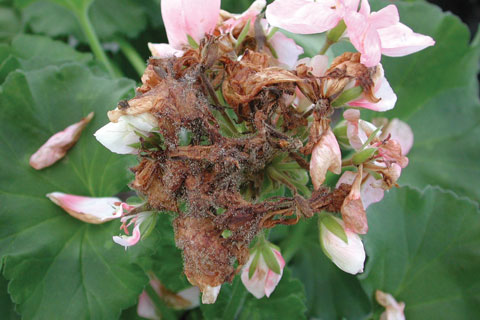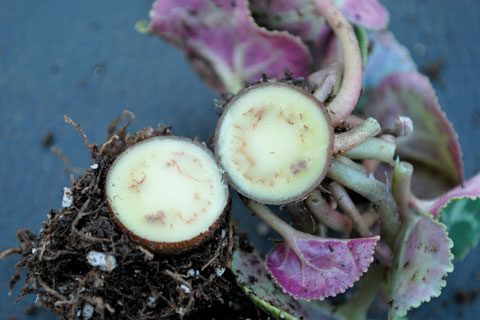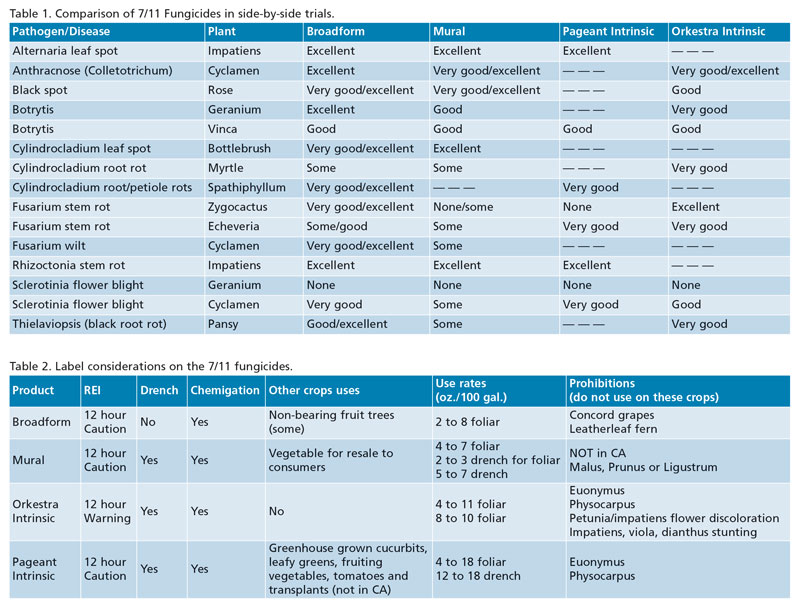2/1/2020
The Convenience of 7/11
A. R. Chase

My first experiences with strobilurin (FRAC 11) fungicides was with Heritage (azoxystrobin) and Compass (trifloxystrobin). For years, we did research on these two strobilurins, as well as krgeosim methyl (Cygnus—no longer marketed) and metaminostrobin (now marketed as Fame). I did many trials comparing at least them and learned their relative strengths. It was clear that the upwardly systemic azoxystrobin was more effective on certain diseases, while trifloxystrobin was able to penetrate leaves but not move systemically.
Pictured: Figure 1. Botrytis blight on geranium.
The pathogens they each excelled on were determined by where the fungus was in the plant. For example, trifloxystrobin was better on Botrytis, which was on the outer tissues, while azoxystrobin was better on downy mildews, which were sometimes systemic.
Fast forward to the advent of the FRAC 7/11 combinations. The first 7/11 fungicide available to the ornamental industry was Pageant Intrinsic (pyraclostrobin and boscalid). We researched it extensively while we had our research operation in Northern California. During the same timeframe, we did trials on Empress Intrinsic (pyraclostrobin) as a standalone strobilurin (FRAC 11). Pageant Intrinsic was launched around 2008. In 2013 or so, Mural (azoxystrobin and solatenol) and Orkestra Intrinsic (pyraclostrobin and fluxapyroxad) were launched.
 As we’d moved to Arizona in the interim and stopped research in that period, I had no personal experience with these two new 7/11 fungicides. Most recently, Broadform (trifloxystrobin and fluopyram) was launched. Luckily, we’re back in the research trial business and we’ve been able to do many trials in the past two years on Broadform. I also decided to get caught up on what I knew about Mural and Orkestra Intrinsic, so we’ve done a number of trials in the past two years on at least three of the four 7/11 products. We’ve also trialed a number of new FRAC 7 products that don’t contain a strobilurin (like Astun [isofetamid]) and at least three numbered compounds with different FRAC 7 active ingredients.
As we’d moved to Arizona in the interim and stopped research in that period, I had no personal experience with these two new 7/11 fungicides. Most recently, Broadform (trifloxystrobin and fluopyram) was launched. Luckily, we’re back in the research trial business and we’ve been able to do many trials in the past two years on Broadform. I also decided to get caught up on what I knew about Mural and Orkestra Intrinsic, so we’ve done a number of trials in the past two years on at least three of the four 7/11 products. We’ve also trialed a number of new FRAC 7 products that don’t contain a strobilurin (like Astun [isofetamid]) and at least three numbered compounds with different FRAC 7 active ingredients.
Figure 2. Fusarium wilt on cyclamen.
I’m frequently asked for recommendations on fungicide programs for specific needs and sometimes as a means to prevent ALL diseases on ALL plants. The number of products in general that are available for the ornamental industry increases every year and deploying them effectively is a very complex problem. One of the most complex groups is the FRAC 7 and FRAC 11 premixes that are now available. I set out to see if I could generalize how I saw their use. To do so, I first gathered all published trials I could locate and then started doing side-by-side comparisons on as many different fungal diseases as I could. To make a complex situation clear, you first have to get even more complex.
 Table 1 shows the trials we did (as well as those published by other researchers) on these premixes in the past few years. The level of control for each fungicide is shown in the upper row of each disease entry in a side-by-side trial. This means they were compared in exactly the same trial. In some cases, all 7/11 weren’t included in single trials and these are shown as three dashes. In other cases (like Broadform), there’s no history of efficacy on certain targets based on current labeling. Broadform isn’t labeled at this time for use as a drench on certain soil-borne diseases.
Table 1 shows the trials we did (as well as those published by other researchers) on these premixes in the past few years. The level of control for each fungicide is shown in the upper row of each disease entry in a side-by-side trial. This means they were compared in exactly the same trial. In some cases, all 7/11 weren’t included in single trials and these are shown as three dashes. In other cases (like Broadform), there’s no history of efficacy on certain targets based on current labeling. Broadform isn’t labeled at this time for use as a drench on certain soil-borne diseases.
For a large range of diseases, each 7/11 premix works very well to excellent, or at least more or less the same, giving none of them an edge. These diseases include: Alternaria, Anthracnose, black spot, Cylindrocladium, Sclerotinia and Rhizoctonia. For Botrytis and Sclerotinia, I would probably suggest Astun or Broadform. While Pageant Intrinsic has performed really well in the past, resistance to boscalid does exist widely in non-ornamental crops (based on published research) and I’ve seen failures in our ornamental trials for the past few years.
For powdery mildew, Orkestra Intrinsic and Broadform have performed a little better than Mural. Orkestra Intrinsic has performed exceedingly well in our Fusarium trials. For rust diseases, Mural is outstanding.
Because I like numbers, I decided to assign each product an average rating using this scale: 0 = none; 1 = some; 2 = good; 3 = very good; and 4 = excellent. Then I averaged all of these numbers for the product. That gives Broadform an overall very good control rating, Orkestra Intrinsic a good to very good rating, and Mural and Pageant Intrinsic a good rating.
Since there are more things than efficacy trials that enter into a decision on what products to use, I summarized some of the aspects of the labels for each of the products in Table 2. As you can see, there are many similarities (12-hour REI and legal for chemigation on all of them) and some real differences in the labels for these four fungicide products.
* Broadform isn’t currently labeled for drenching.
* Mural isn’t labeled in California yet.
* Orkestra Intrinsic is only labeled on ornamentals.
But the labels (and the products) are more alike than different.
Conclusions
So you can fall back to the primary way you choose a fungicide—cost. Be sure to check real cost and not container cost. Real cost involves knowing the effectiveness, interval, safety and use rates. The use rates do differ, and in some key diseases, using the most effective product is the difference between success and failure. But overall, it pains me to say it, but choosing a FRAC 7/11 fungicide doesn’t have to be really complicated—they’re all very good products for ornamentals. GT
A. R. Chase is a plant pathologist and president of Chase Agricultural Consulting, LLC in Cottonwood, Arizona. She can be reached at archase@chaseresearch.net.